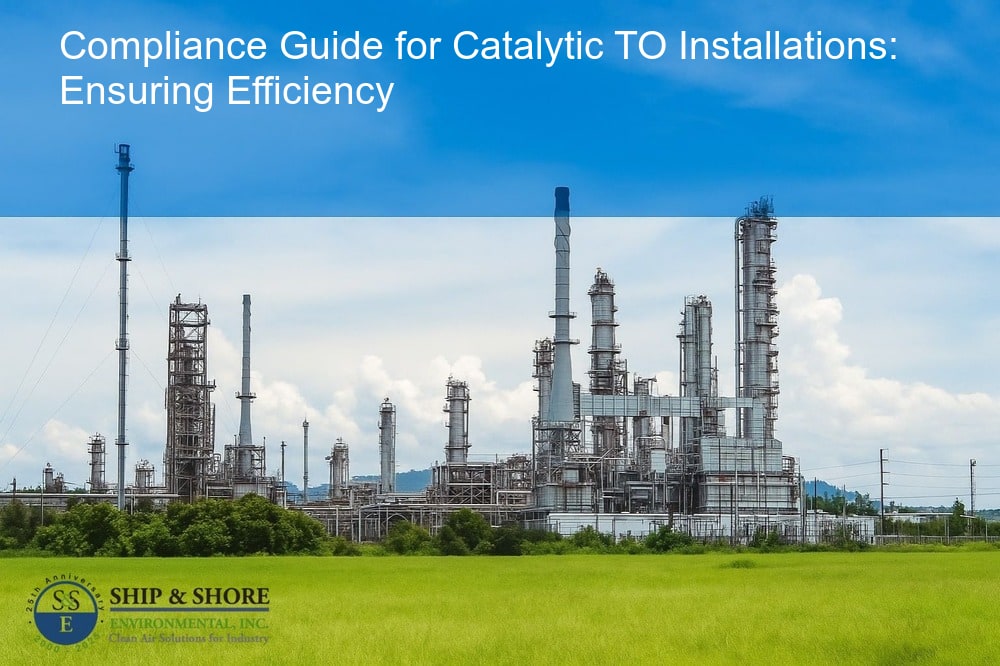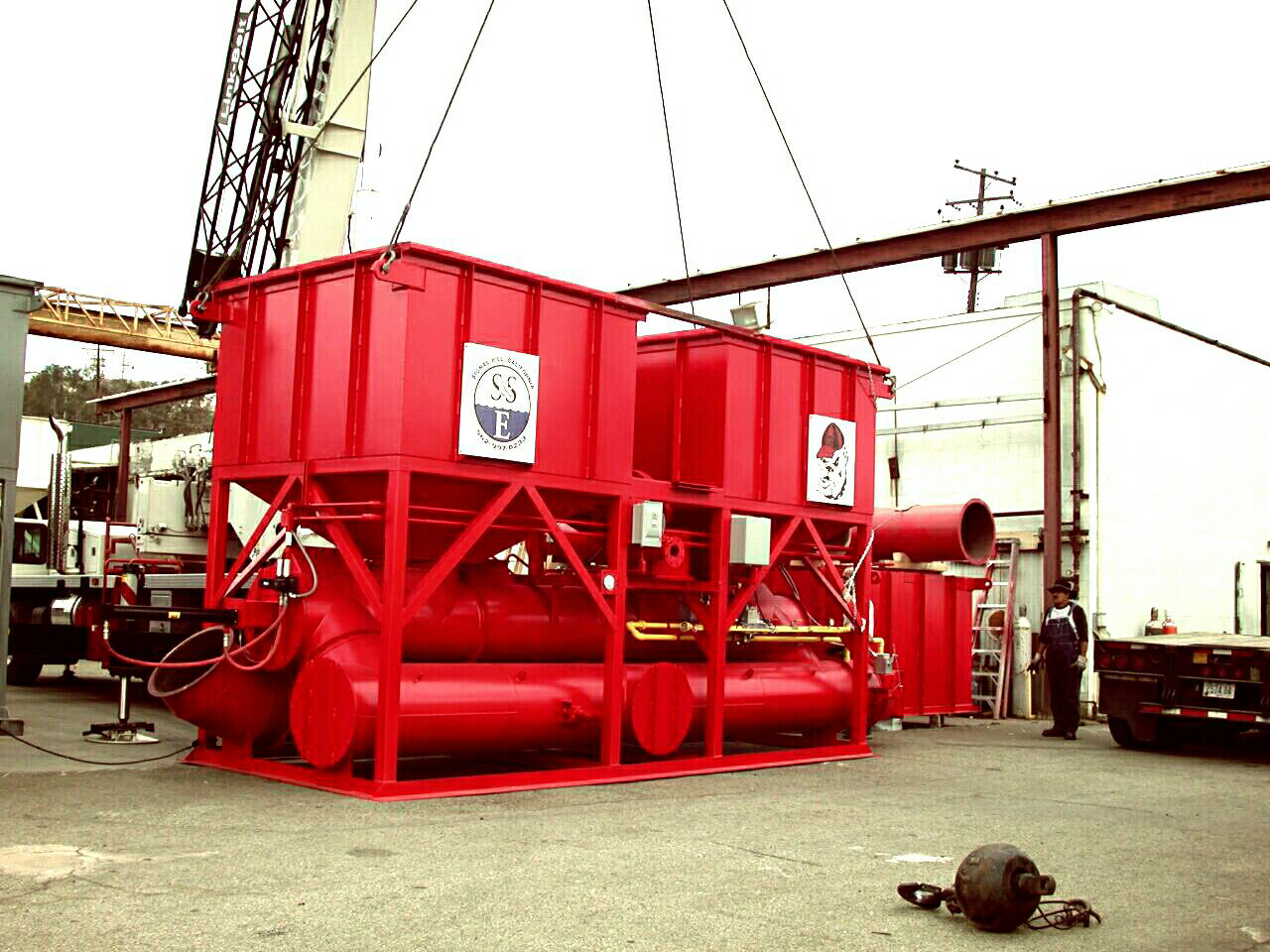
Compliance Guide for Catalytic TO Installations: Key Steps
August 18, 2025 2:10 amUnderstanding Catalytic Thermal Oxidizers (TO): A Brief Overview
In today’s industrial landscape, compliance with environmental regulations is not just a legal obligation but also a commitment to sustainability. At Ship & Shore Environmental, Inc., we understand the significance of implementing effective technologies that aid in achieving regulatory compliance. Our comprehensive compliance guide for catalytic TO installations provides an invaluable resource for industries striving to meet stringent environmental standards.
Catalytic Thermal Oxidizers (TO) are a crucial component in this endeavor. They function by using a catalyst to oxidize and decompose hazardous pollutants into less harmful substances such as carbon dioxide and water vapor. Unlike conventional thermal oxidizers, catalytic TOs operate at lower temperatures, enhancing energy efficiency while still ensuring high destruction efficiency of volatile organic compounds (VOCs) and hazardous air pollutants (HAPs).
The Importance of Catalytic TO Installations in Industrial Compliance
Industries emitting VOCs and HAPs are required by law to take measures to control and reduce these emissions. Failure to do so can result in substantial fines, legal actions, and harm to your company’s reputation. Catalytic TOs play a pivotal role in this context. With their ability to efficiently manage and neutralize harmful emissions, they help industries stay compliant with regulations such as the Clean Air Act.
Moreover, the integration of catalytic TOs into your operational framework demonstrates a commitment to corporate social responsibility and environmental stewardship. This not only helps in passing regulatory inspections but also can significantly enhance your company’s public image and stakeholder satisfaction.
Aiming for Compliance: How Catalytic TO Installations Aid Industrial Regulations Compliance
One of the primary concerns for any industry is staying updated and compliant with evolving environmental regulations. Our compliance guide for catalytic TO installations outlines a clear roadmap for achieving this. From understanding regulatory requirements to implementing the right systems and practices, our guide ensures that your operations are always in line with the latest standards.
Catalytic TOs serve as an effective solution by efficiently targeting and treating emission sources that are non-compliant. Their advanced design allows for the treatment of both low and high concentrations of VOCs, making them versatile across various industrial applications. The incorporation of these systems into your environmental control strategy ensures that your facility not only meets but exceeds regulatory requirements, thus providing a buffer against future regulatory changes.
Catalytic TO Installations: An In-Depth Look into Their Design and Function
At Ship & Shore Environmental, Inc., we specialize in providing solutions that are not only effective but essential for meeting stringent industrial emission standards. Catalytic Thermal Oxidizers (TO) are vital components of our environmental compliance strategies. Catalytic TO installations use a catalyst to facilitate the oxidation of volatile organic compounds (VOCs) at lower temperatures than conventional thermal oxidizers. As a result, they are both energy-efficient and highly effective in reducing harmful emissions.
Our catalytic TO systems comprise several key components: a preheater to raise the temperature of incoming exhaust gases, a catalytic bed where the actual oxidation occurs, and a heat exchanger to recover and reuse energy. This design ensures optimal performance, meeting regulatory standards while minimizing operational costs.
Implementing Catalytic TO Installations: Step-by-step Compliance Guide
Our step-by-step compliance guide for catalytic TO installations ensures a smooth and efficient process. Before implementation, we conduct a thorough assessment of the specific needs and conditions of your industrial operation. This preliminary evaluation helps in selecting the right catalytic TO system tailored to your requirements.
Following the assessment, we move on to the design phase. Here, our engineers create detailed plans that outline the installation process, ensuring all components are optimized for your setup. The third step involves procurement and fabrication, during which we source the highest quality materials and construct the catalytic TO system.
- Assessment: Evaluate site-specific needs.
- Design: Develop customized installation plans.
- Procurement and Fabrication: Source materials and construct system.
- Installation: Execute installation plan.
- Testing and Commissioning: Verify system performance.
During the installation phase, our team follows the predetermined plans meticulously. We ensure that all components are installed correctly and integrated seamlessly with your existing operations. Once installation is complete, rigorous testing is conducted to verify that the system performs as expected. Finally, we commission the system, ensuring it meets all required regulatory standards and operates efficiently.
Key Factors to Consider for Successful Catalytic TO Installation
Several factors contribute to the success of our catalytic TO installations. First and foremost is the selection of an appropriate catalyst. The catalyst must be compatible with the types of VOCs present in the exhaust gases. Moreover, understanding the flow rate and temperature of the exhaust gas stream is crucial to ensure optimal operation.
Another key factor is the integration of the catalytic TO system with existing processes. This involves ensuring that the system operates harmoniously with other equipment, minimizing disruptions. Proper insulation and maintenance considerations are essential for long-term reliability.
Lastly, we recognize the importance of regulatory compliance. Our installations are designed to meet or exceed local and federal emission standards. We also provide comprehensive training to your team, ensuring they understand how to operate and maintain the system effectively. By doing so, we facilitate ongoing compliance, reducing the risk of violations and associated fines.
Did you know that catalytic thermal oxidizers not only ensure industrial compliance but also significantly reduce harmful pollutants by transforming them into harmless substances like water and carbon dioxide using less energy?
Evaluating the Efficiency of Catalytic TO Installations: Assessment and Regular Maintenance
Regular assessment and maintenance are crucial for the optimal performance of catalytic thermal oxidizers. These practices ensure that our installations operate at peak efficiency, meeting the stringent industrial regulations. Regular checks help in identifying wear and tear and any arising issues, allowing for timely interventions. With Ship & Shore Environmental, Inc. providing expert guidance and services, maintaining the efficiency of your catalytic TO is streamlined and effective.
Improving Environmental Sustainability: The Role of Catalytic TO Installations
Our catalytic TO installations play a significant role in enhancing environmental sustainability. By reducing harmful emissions, these systems contribute to a cleaner environment and promote industrial practices that align with eco-friendly standards. With the right catalytic oxidizers in place, industries can significantly lower their carbon footprint while maintaining compliance with environmental regulations.
Future Prospects: The Increasing Importance of Compliance Guide for Catalytic TO Installations
As environmental regulations continue to evolve, the importance of a detailed compliance guide for catalytic TO installations becomes ever more critical. Staying ahead of regulatory changes and adopting best practices ensures that our clients are always compliant. This not only avoids potential penalties but also enhances the reputation of the company within the industry. At Ship & Shore Environmental, Inc., we are committed to providing up-to-date compliance guides that aid in seamless installations and operations of catalytic TO systems.
FAQ
How do regular assessments improve the efficiency of catalytic thermal oxidizer installations?
Regular assessments are vital to ensure that catalytic thermal oxidizers operate efficiently. They help in the early detection of any issues such as wear or malfunctions, allowing for timely interventions. By doing so, we can guarantee that our installations consistently meet industrial regulations and remain effective in controlling pollution, thereby sustaining peak performance and reliability.
What role do catalytic TO installations play in enhancing environmental sustainability?
Our catalytic TO installations play a pivotal role in promoting environmental sustainability. By efficiently breaking down harmful pollutants into less harmful substances, they significantly reduce industrial emissions and thus minimize the environmental impact. Consequently, this allows industries to not only meet regulatory standards but also to demonstrate their commitment to eco-friendly practices.
Why is it important to stay updated with the latest regulatory changes for catalytic TO installations?
Staying updated with the latest regulatory changes is crucial for maintaining compliance with environmental standards. As regulations evolve, our compliance guides and expertise ensure that your catalytic TO installations are up to the current standards. Thus, it prevents any potential legal issues and fosters a proactive approach to environmental responsibility.
How often should maintenance be conducted on catalytic TO installations?
Maintenance frequency for catalytic TO installations can vary based on operational conditions and manufacturer recommendations. However, a regular maintenance schedule should be established to ensure optimal functionality. Besides routine checks, in-depth maintenance is recommended at least annually to address any wear and potential efficiency issues, keeping the systems in line with compliance requirements.
What are the key factors to consider when implementing a catalytic TO installation?
When implementing a catalytic TO installation, several key factors must be considered for successful operation. These include the specific industrial process requirements, the type and concentration of pollutants, the desired efficiency, and the compliance regulations applicable to those emissions. Additionally, considering the availability of space and the integration with existing systems is necessary for a seamless installation.
Categorised in: Blog

